When does a road car stop being just a car and start becoming a race machine in disguise?
In today’s performance era, the line between track and street has never been thinner. From the shrieking V12s of Ferrari to the hybrid precision of Mercedes-AMG, modern engineering has allowed us to experience true race power on public roads. These road cars with race engines are not just fast—they redefine what street performance means.
Every model in this list carries genuine motorsport DNA. They are built using technologies born on the world’s most demanding circuits: Formula 1, Le Mans, and GT3 racing. Whether it’s the instant throttle response, spine-tingling sound, or the way they carve corners, each machine connects drivers to the raw essence of competition.
So, buckle up. Here are the Top 10 Road Cars with Race Engines That Redefine Street Performance—machines that bring the spirit of the track to your everyday drive.
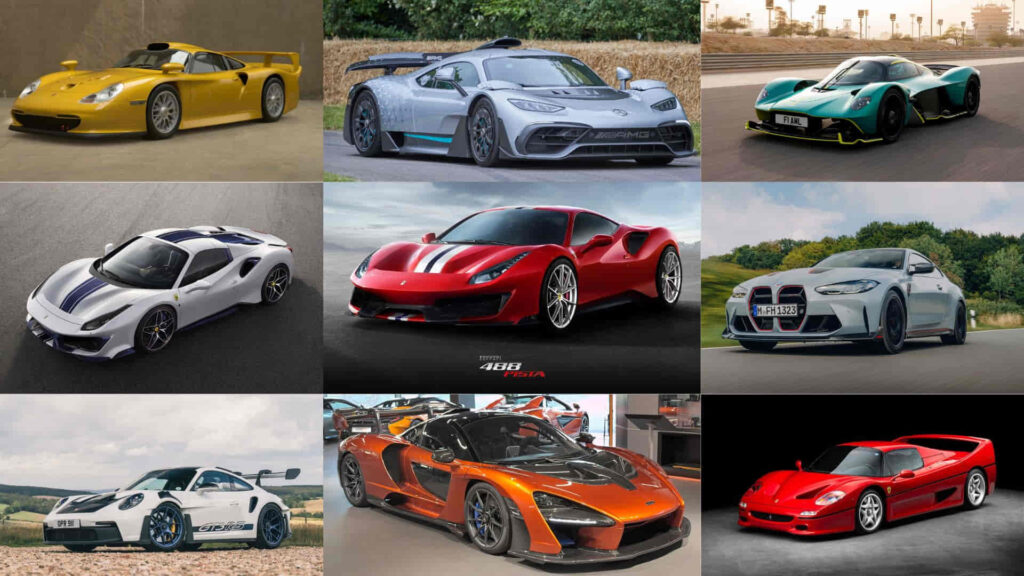
Contents
- Criteria for Selection
- Nissan GT-R NISMO (GT3-derived V6 Power)
- Porsche 911 GT3 RS (Motorsport DNA in Every Bolt)
- BMW M4 CSL (DTM-Inspired Engineering)
- Ferrari F50 (F1 Engine for the Road)
- Mercedes-AMG ONE (F1 Hybrid Powertrain)
- McLaren Senna (Extreme Track Focus, Street Approved)
- Aston Martin Valkyrie (Le Mans DNA Unleashed)
- Porsche 911 GT1 Straßenversion (True Race Car with License Plates)
- McLaren F1 (Le Mans Winner Turned Street Legend)
- Ferrari 488 Pista (Track Performance Perfected for Streets)
- Conclusion
Criteria for Selection
Not every fast car qualifies as a true race-engine road car. For this list, every model had to meet strict performance and engineering criteria.
First, each vehicle must feature an engine directly derived from motorsport programs—whether Formula 1, GT3, or endurance racing. The heart of these cars was born to compete, not merely to commute.
Second, they must be fully road-legal, capable of being registered and driven on public streets, even if their soul belongs on the track.
Finally, the selection prioritizes balance and authenticity: raw power combined with precise handling, aerodynamic innovation, and an emotional connection to racing heritage.
These aren’t just fast cars—they are living proof that motorsport engineering can exist in harmony with everyday drivability.
Nissan GT-R NISMO (GT3-derived V6 Power)

The Nissan GT-R NISMO stands as one of the purest connections between road and race. Born from Nissan’s GT3 racing program, this machine carries the same DNA that has dominated endurance tracks around the world. Under its sculpted hood lies a 3.8-liter twin-turbocharged V6 engine, hand-built by Takumi master craftsmen—the same engineers who assemble Nissan’s GT3 race engines.
Producing over 600 horsepower, the GT-R NISMO delivers brutal acceleration and near-supercar performance. But its brilliance lies not only in raw power—it’s in the way it channels that force. The car’s advanced ATTESA E-TS all-wheel-drive system and NISMO-tuned suspension give it razor-sharp precision through every corner, echoing the confidence of a true race car.
While its aggressive aerodynamics and track-ready chassis scream “motorsport,” it remains surprisingly livable on public roads. The GT-R NISMO proves that a road car with a race engine can still offer daily usability—without losing an ounce of its racing soul.
Porsche 911 GT3 RS (Motorsport DNA in Every Bolt)

Few cars embody the phrase “from track to street” as completely as the Porsche 911 GT3 RS. Every inch of this car is infused with motorsport intent, built upon decades of Porsche’s dominance in GT racing. Its beating heart is a 4.0-liter naturally aspirated flat-six engine, directly descended from the 911 GT3 Cup race car—a masterpiece that revs all the way to 9,000 rpm and sings with unfiltered mechanical purity.
Weighing just over 1,450 kilograms and engineered with extensive use of carbon fiber, the GT3 RS is designed for aerodynamic perfection. The enormous rear wing and track-focused suspension allow it to corner with surgical precision, mirroring the agility of Porsche’s race machines.
Despite its ferocity on the circuit, it remains road-legal and surprisingly approachable for those skilled enough to tame it. The 911 GT3 RS doesn’t just share racing DNA—it is racing DNA, refined into one of the most exhilarating road cars with race engines ever built.
BMW M4 CSL (DTM-Inspired Engineering)
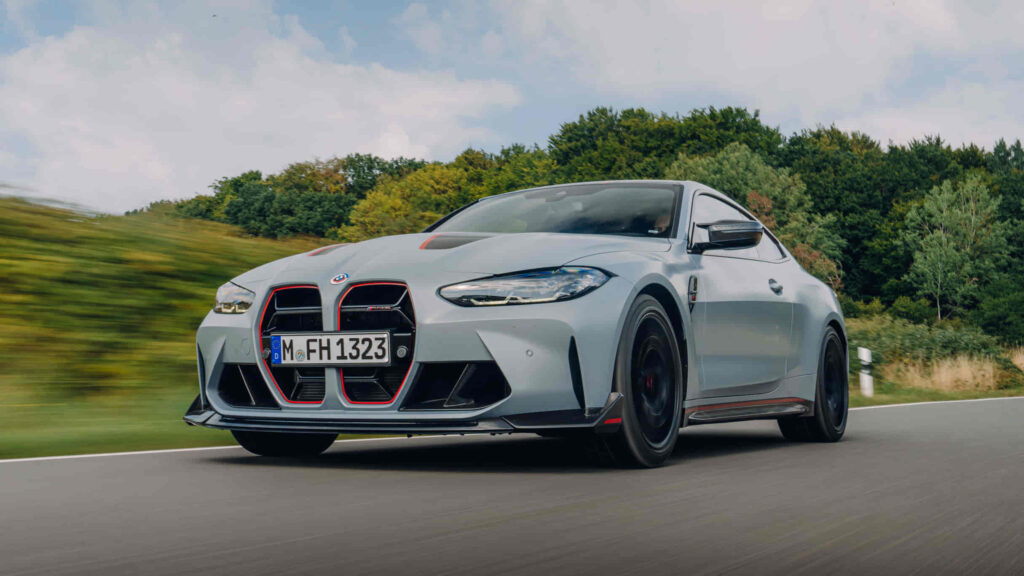
The BMW M4 CSL is not just another high-performance coupe—it’s a direct descendant of BMW’s DTM (Deutsche Tourenwagen Masters) racing heritage. Every detail of the CSL, from its powertrain to its chassis geometry, reflects BMW’s obsession with transforming racing expertise into road-going precision.
Under the hood lies a 3.0-liter twin-turbo inline-six engine, producing 543 horsepower and optimized using lessons learned from BMW’s factory race cars. Its power delivery is instantaneous, supported by a lightweight construction that trims more than 100 kilograms from the standard M4 Competition. The result is a machine that reacts to every driver input like a track car wearing license plates.
Carbon fiber seats, ceramic brakes, and a track-tuned suspension make the CSL a purist’s dream. Every vibration, every shift, every roar from the exhaust reminds you of its DTM bloodline. The M4 CSL isn’t about comfort—it’s about feeling the raw, mechanical honesty of a race engine on everyday roads.
Ferrari F50 (F1 Engine for the Road)

The Ferrari F50 remains one of the purest expressions of Formula 1 engineering ever put on public roads. Released in 1995 to celebrate Ferrari’s 50th anniversary, it was not designed for comfort or convenience—it was built to bring the F1 experience directly into the hands of its drivers.
At its core lies a 4.7-liter naturally aspirated V12, derived from the same engine architecture used in Ferrari’s early-1990s Formula 1 cars. Mounted directly to the carbon-fiber monocoque as a stressed member, this engine doesn’t just power the car—it forms part of its structure, exactly like an F1 racer. The result is razor-sharp feedback, spine-tingling sound, and an almost telepathic connection between car and driver.
With no power steering, no electronic traction aids, and a six-speed manual gearbox, the F50 delivers the kind of raw engagement modern supercars rarely achieve. It is the embodiment of a true road car with a race engine—unfiltered, emotional, and unapologetically mechanical.
Mercedes-AMG ONE (F1 Hybrid Powertrain)
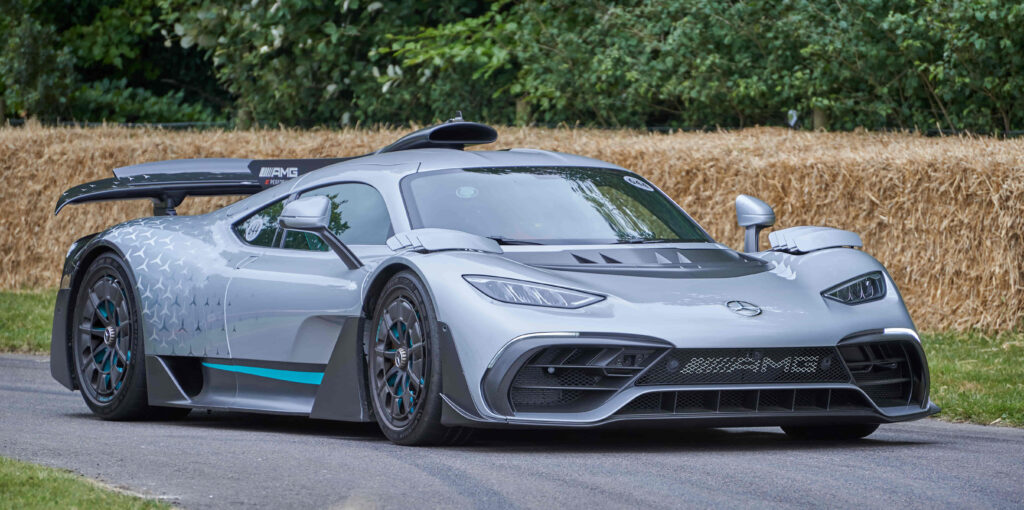
The Mercedes-AMG ONE is the ultimate proof that Formula 1 engineering can, indeed, conquer public roads. Developed in partnership with the Mercedes-AMG Petronas F1 Team, the ONE brings a real F1 power unit—not just technology, but the actual engine architecture—into a street-legal hypercar.
Its heart is a 1.6-liter turbocharged V6 hybrid engine, directly derived from Lewis Hamilton’s championship-winning Formula 1 car. Paired with four electric motors, it produces a mind-bending 1,063 horsepower, launching from 0 to 200 km/h in under 7 seconds. Every element—from the single-clutch automated gearbox to the high-revving 11,000 rpm limit—mirrors F1 performance engineering.
Even its aerodynamic systems are pure motorsport art: adjustable wings, active flaps, and air channels sculpted for downforce and cooling. Despite its track-born complexity, the AMG ONE is fully road-legal, making it one of the most technologically advanced road cars with race engines ever created. It’s not just a car—it’s Formula 1, tamed.
McLaren Senna (Extreme Track Focus, Street Approved)
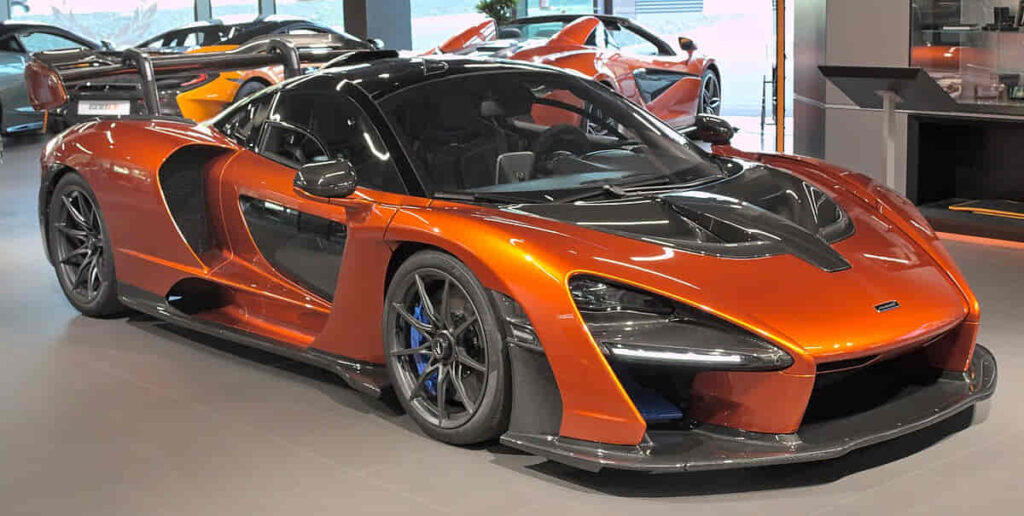
The McLaren Senna isn’t just named after a legend—it was built to honor one. Inspired by Ayrton Senna’s relentless pursuit of perfection, this hypercar distills McLaren’s Formula 1 expertise into an uncompromising road-legal track machine. Everything about the Senna is designed around one goal: the purest connection between car, driver, and asphalt.
Power comes from a 4.0-liter twin-turbocharged V8, producing 800 horsepower, paired with an ultra-light carbon-fiber chassis that tips the scales at just 1,198 kilograms. The result is staggering performance—0 to 100 km/h in just 2.8 seconds—and handling that feels more race car than road car.
Its massive active aerodynamics, including the signature hydraulic rear wing, generate extreme downforce, allowing the Senna to attack corners with surgical precision. Yet, despite its track-focused nature, it remains street-legal, offering a visceral reminder that some road cars with race engines aren’t built for luxury—they’re built to make you feel alive.
Aston Martin Valkyrie (Le Mans DNA Unleashed)
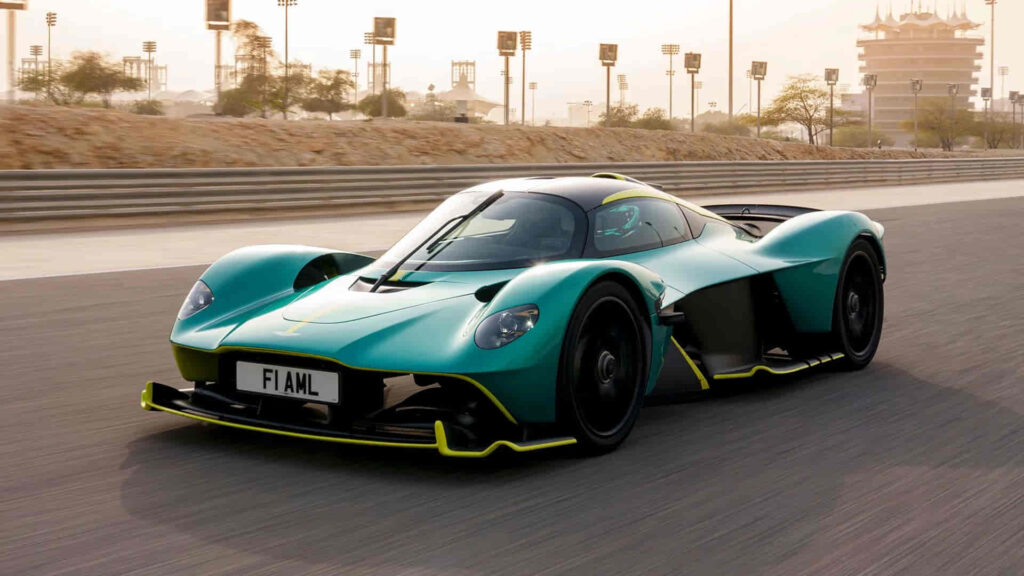
The Aston Martin Valkyrie is what happens when a Le Mans prototype escapes the racetrack. Born from a collaboration between Aston Martin, Red Bull Advanced Technologies, and Cosworth, it represents the closest thing to a full-fledged endurance racer ever made road-legal.
At its core lies a 6.5-liter naturally aspirated V12 engine, developed by Cosworth and revving to an astronomical 11,100 rpm. Producing 1,160 horsepower when paired with its electric hybrid system, the Valkyrie delivers the kind of sound and response only race engines can produce. Every component—down to the carbon-fiber suspension arms—was designed with one purpose: to replicate Le Mans-level performance on public asphalt.
Inside, drivers are cocooned in a carbon monocoque tub with F1-style seating and controls. Nothing about the Valkyrie is ordinary. It’s an engineering statement, a living testament that road cars with race engines can be more than fantasy—they can be the ultimate fusion of art, science, and speed.
Porsche 911 GT1 Straßenversion (True Race Car with License Plates)

The Porsche 911 GT1 Straßenversion isn’t a road car inspired by racing—it’s a race car reluctantly made road-legal. Created in the late 1990s to meet FIA homologation rules for Le Mans competition, the GT1 Straßenversion (German for “street version”) is as close as it gets to driving a real endurance racer on public roads.
Underneath its sleek composite body lies a 3.2-liter twin-turbocharged flat-six engine, derived directly from the 911 GT1 Le Mans race car. It delivers 537 horsepower, sending power through a sequential-style gearbox and a lightweight rear-wheel-drive layout. The chassis, suspension, and aerodynamics are nearly identical to its track counterpart—no compromises, no comfort padding, just raw competition engineering.
Owning a GT1 Straßenversion means living with a machine built for victory, not convenience. With only 20 units ever made, it remains one of the rarest and most authentic road cars with race engines in existence—an artifact of a golden era when the line between street and circuit simply vanished.
McLaren F1 (Le Mans Winner Turned Street Legend)
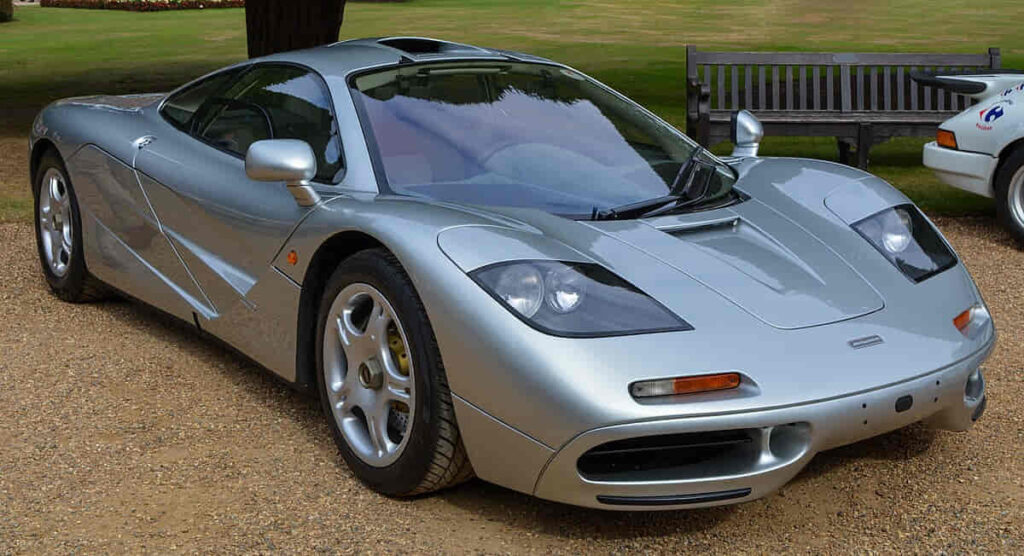
The McLaren F1 isn’t just a supercar—it’s a piece of motorsport history that rewrote what a road car could be. Designed in the early 1990s by legendary engineer Gordon Murray, the F1 was created with a single vision: to bring the purity of race engineering to the streets without compromise.
At its heart lies a 6.1-liter naturally aspirated BMW V12 engine, developed by BMW Motorsport exclusively for McLaren. Producing 627 horsepower and capable of revving past 8,000 rpm, it remains one of the most celebrated race-derived engines ever built. The F1’s carbon-fiber monocoque chassis—the first of its kind in a production car—helped it achieve a record top speed of 386 km/h, a figure that stood unchallenged for over a decade.
In 1995, a slightly modified version of this very car won the 24 Hours of Le Mans, beating purpose-built race cars. That victory made the McLaren F1 the ultimate embodiment of road cars with race engines—a machine that didn’t just imitate racing pedigree, but proved it on the world’s toughest stage.
Ferrari 488 Pista (Track Performance Perfected for Streets)

Sitting at the very top of this list, the Ferrari 488 Pista represents the perfect harmony between race engineering and road usability. Its name—Pista, meaning “track” in Italian—reveals its true identity: a road car designed to perform like a purebred racing machine.
Powering this masterpiece is a 3.9-liter twin-turbocharged V8 engine, directly derived from the 488 Challenge race car. With 710 horsepower and lightning-fast throttle response, it delivers performance that feels surgically precise yet emotionally explosive. The engine’s lightweight components, advanced cooling system, and race-spec turbos make it the most powerful V8 in Ferrari’s history at the time of launch.
Aerodynamics were developed using lessons from Ferrari’s GT racing program—S-ducts, vortex generators, and an active rear diffuser all work together to glue the car to the asphalt. Despite its track-focused setup, the 488 Pista remains remarkably balanced and engaging on normal roads. It’s the ultimate expression of a road car with a race engine—a fusion of science, soul, and speed that redefines what “street performance” truly means.
Conclusion
From Formula 1-derived hybrids to Le Mans-bred legends, these road cars with race engines represent the pinnacle of automotive engineering and passion. Each one carries the DNA of motorsport—precision, power, and purpose—refined just enough to survive the demands of public roads.
Whether it’s the raw mechanical thrill of the Ferrari F50, the high-tech brilliance of the Mercedes-AMG ONE, or the balanced perfection of the Ferrari 488 Pista, these machines prove that racing innovation doesn’t belong solely on the track. They are rolling masterpieces, built for those who crave more than transportation—for those who want to feel the race with every heartbeat and every gear shift.
In the end, these cars aren’t about speed alone—they’re about connection. A connection to history, to technology, and to the purest form of driving ever created. Which one of these incredible road cars with race engines would you dare to drive?